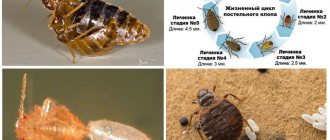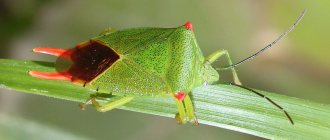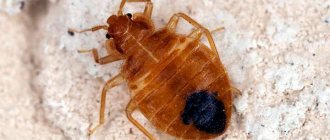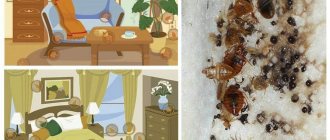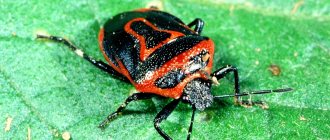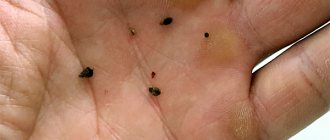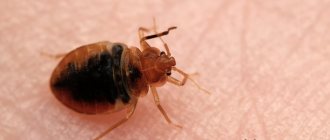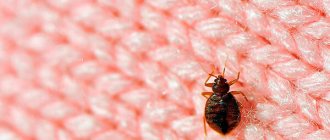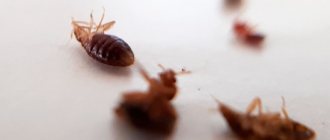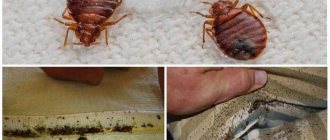Often, house or bed bugs are found in the house, which, unlike other uninvited guests - cockroaches or flies, feed on human blood. The bites of these insects are simply impossible not to notice. It is necessary to get rid of parasites as quickly as possible, since the insect population in the apartment will grow every day. What do bed bugs look like, what size are they, and how can you detect them in order to remove them?
Appearance of bed bugs
The appearance of bed bugs - their color and size - can vary depending on whether the insect is hungry or well-fed.
Size of house bugs
House bugs, or bed bugs, as they are also called, are small parasitic insects. The size of an adult reaches up to 3 to 8 mm. The peculiarity of these insects is that they can increase in size depending on whether they have obtained blood.
Without food, an adult insect has a round shape. House bugs also change their color - if the insect does not get food for itself, it will have a light brown color.
After drinking blood, the bug can double in size and darken significantly. An adult can take in a fairly large portion of blood. The larvae of house bugs also feed on blood and change their color, as can be seen in the photo.
What do small bugs look like?
These insects do not have wings. However, they have legs with interesting serrations that allow them to crawl even on the ceiling. House bugs cannot jump or fly, but their flattened body and jagged legs allow them to quickly run away and hide in the cracks of furniture as soon as someone tries to catch them. Bed bugs are vulnerable only after saturation, since their heavy body, which has increased in size, does not allow them to move quickly.
On average, a domestic bug lives about a year and a half. The peculiarity of the structure of the parasites’ body is such that they can remain without food for a long time (up to 6 months). Without nutrition, the insect's development is inhibited and it goes into hibernation.
Young individuals of the house bug are practically no different in structure from adults. Bed bugs begin to hunt in the morning. These insects are surprisingly resistant to low and high temperatures, and die only in frosts of -20 degrees or in heat above +50 degrees.
How to distinguish a female bedbug from a male
Like many other subspecies of arthropods, the females of house bugs are somewhat larger than the males. The female has a slightly rounded abdomen. The lower part of the body on the sides in females is slightly expanded.
Feedback from our readers:
“Everything we tried to fight these parasites, we thought it would last forever!!! And then the salesperson in the store advised me to take GEKTOR against bed bugs. Oh miracle!!! We didn't believe it ourselves! Peace and grace! Nobody bites, this stench has disappeared from the apartment! In general, life has improved. Let’s sleep peacefully now!”
Andrey, Tula
The modern medicine for bedbugs, Hector, is a fairly effective remedy for bedbugs that allows you to carry out extermination work with maximum effect and minimal consequences.
It is worth noting that one treatment of an apartment will not give a 100% guarantee that all bedbugs will disappear, even if the best product was used. This is explained by the fact that during treatment with poison, you may not notice some bedbug eggs, or the bedbug simply found a secluded place and went through hard times. And then he got out and began to restore the population with even greater diligence.
Therefore, many insecticidal preparations are recommended to be used twice at weekly intervals. The second treatment is intended to destroy the remaining individuals. This sequence of actions ensures the full effect of the treatment.
Today on the market there are many effective means for killing bedbugs that will help you deal with the problem quickly and without unnecessary hassle!
Structure of a bedbug
The body of a domestic bug consists of only three sections: the head, thorax and abdomen. The chest and abdomen of this parasite are segmented. All parts of the body of bedbugs are held together by fairly dense chitin, which is covered with short hairs.
The head of a house bug is the most important part. It contains:
- Protruding eyes, very sensitive to light. Although studies have shown that bloodsuckers have very poor vision, they still perfectly distinguish all shades of red. The red color for bedbugs is associated with relatives, warmth, and prey.
- There are long antennae on the head that serve as tactile and olfactory organs. Antennae for bedbugs are a kind of antennas, thanks to which insects are perfectly oriented in space. With the help of antennae, a bedbug can find shelter or other bedbugs.
- The proboscis, with which bedbugs suck blood, is also located on the head. Externally, the proboscis is invisible, since it is curved under the abdomen. This organ consists of piercing bristles. The bug pierces the skin with its proboscis, injects an enzyme and sucks out the blood. Thanks to a special enzyme, at the moment of the bite the animal or person does not feel anything, but notices the punctures only after a while.
The chest of a domestic bug also consists of several segments. There are three pairs of legs on it, and shortened elytra are present. These insects are not adapted for flight, and they do not have wings. Bedbugs are saved only by fast pairs of legs.
The abdomen of a house bug consists of approximately 10 segments. Along the edges of the insect's abdomen there are spiracles. On the body, immediately after the third pair of legs, bedbugs have glands that secrete a secretion with a pungent odor in case of danger. The last segment contains the genitals and the posterior opening.
Folk remedies
A reliable way is to get rid of pests using high temperature. It is necessary to treat bedbug nests using a steam generator. An ordinary household hair dryer will not work - it will not be able to maintain a high temperature for a long time. Insect nests and possible places of their stay are processed.
Folk recipes suggest using products with a pungent odor, for example, kerosene, vinegar, turpentine. When diluted, these substances are used to lubricate baseboards, bed legs, and furniture parts. But the pungent smell will be unpleasant for humans and pets, and they will have to leave the apartment for a while.
You can use aromatic oils and herbs with a more pleasant aroma for humans. Essential oils of tea tree, eucalyptus, and orange are not liked by bedbugs. Among the plants they do not like tansy and wormwood. But it should be remembered that parasites do not die from odors, but only leave the room. There is a risk that they will return after some time.
Bed bug lifestyle
The larval phase of a bedbug takes about a month out of its total lifespan. During this time, bed bugs do not reproduce. The rest of the time, house bugs reproduce very actively. Over the course of her life, one female can lay up to 500 eggs, several per day.
The pest population in the home is growing exponentially. During fertilization, the male pierces the female's abdomen, and she stores the seed within herself throughout her life. The consequences of traumatic penetration of the male genital organ into the abdominal cavity of a female are gradually eliminated thanks to the Berlese organ. This means that domestic bugs can reproduce under any circumstances and even in the absence of males. Most often there are from 3 to 5 eggs in one clutch. Sometimes there are up to 10 eggs in a clutch.
If the owners are not in the house for a long time, then the bedbugs will simply go into hibernation due to lack of food. A domestic bug can remain in suspended animation for up to six months or a year, and at the same time be completely hungry. In this case, the chances of survival for a domestic bug will increase if the room is cool.
Trying to get rid of bed bugs, many people take mattresses and pillows out into the cold of about -10 degrees. This will not help get rid of insects, since they can safely survive the low temperature. Having thawed a little after the frost, the bedbug will immediately attack the food with appetite.
These coleopterous insects, although they do not have full wings, unlike other insects that live in our homes, feed exclusively on blood. In addition to pain at the site of the bite, bedbugs can cause an allergic reaction. But house bugs are not carriers of diseases like flies. Bedbug vinegar causes severe itching and irritation on the skin. Children often scratch wounds and become infected, which can cause serious problems.
Bed bugs are exclusively nocturnal. During the day they rest in dark and warm places. It is enough for this insect to feed on blood once every 5-10 days. Bedbugs search for prey at night. During one saturation, a bug can suck up to 7 mg of blood, which is exactly twice the mass of the insect. It only takes 20 minutes for a bug to suck out this amount of blood.
Bedbugs have a very developed sense of smell, and they distinguish odors very well. This helps them quickly find prey or shelter. So, a bug can hide in a dressing gown and wait for a victim in it.
You can detect that parasites have chosen a bed or sofa only during the day by bites on the skin. If there are several red spots nearby on the skin that cause severe itching, you can be sure that this was done by bedbugs. The parasites are most active from two o'clock in the morning until early morning. It is during this period that most new bites appear.
If the bug is black or dark brown, it means the blood it sucked has already clotted. If the insect is red, it probably just bit someone. After a bite, bedbugs go to the lair to digest the blood. If there is no more food, the pest’s body will become flattened again.
This ability to “deflate” gives insects several survival advantages:
- For example, if a bug dries out and flattens, it will be able to crawl through even a very narrow gap or crack, through a seam. This physical compression of the body will help house bugs to deftly hide and penetrate anywhere. Bedbugs can even live under the frame of a picture or photograph, in the binding of a book, and even in an electronic device, such as an alarm clock.
- Hungry bugs have the ability to move very quickly. Therefore, even after discovering their lair, it will not be possible to catch and crush them all - most of the bedbugs will simply scatter to secluded places. In a hungry state, a bug is almost impossible to catch.
- Even if you flatten a caught bug onto the surface, in its compressed state it is impossible to crush it even with slippers. To crush a bug, you will have to arm yourself with something with a sharp edge - a screwdriver or a pen.
House bugs create nests closer to places where people sleep, so that their prey is nearby. Over time, an insect nest takes on the appearance of accumulated debris. In this lair, bedbugs quickly multiply, moult and lay more and more clutches of eggs. Chitin, feces and other insect waste accumulate in the nests. A bedbug spends most of its life in a dark and secluded place, from where it emerges once every few days to find food. But, if the insect is very hungry, it can attack a person even in the evening under artificial light.
It happens that nests of parasites in the house are organized chaotically. One of the main signs that there are bedbugs in an apartment is a sour smell in the air. House bugs don't smell very pleasant.
Even in a completely empty apartment, bed bugs can survive. But in this case, the bloodsuckers will most likely begin to look for food for themselves. During the day, bedbugs very rarely emerge from their dens.
IMPORTANT
If there are pets in the house, then they too can become prey for bedbugs.
Garden pests and predators
These insects are not dangerous for humans, but they can cause great harm to cultivated plants, as they feed on flower sap. They can only get into the apartment by accident. It’s very easy to get rid of them: pick them up on something and throw them back out the window. The appearance of bugs of the herbivorous group depends on the presence of a defense mechanism and mimicry of dangerous species.
Soldier
Additional names: wingless red bug; Cossack Latin name Pyrrhocoris apterus. Distributed throughout the northern Palearctic, North Africa and North America.
It feeds on plant juices. Can hunt small insects, including its own young. You can see what soldier bugs look like in the photo below. Defense mechanism – unpleasant taste and conspicuous coloring
Redbug
Forest
A group of species of bugs that feed on the sap of grass and young trees. Other names:
- woody;
- stinky;
- garden;
- stink bug;
- herbal.
You can only end up in the house by accident. Usually during forest fires or heavy rains, driving bedbugs out of the forest. These are quite large insects with a body length of more than 1 cm. The forest bug can be recognized by its characteristic body shape, similar to an irregular pentagon, since the color varies from green to brown. The insect is flattened on top.
Woody
The second name for a group of forest bugs. The official name of the “arboreal” species is the green shield bug (Palomena prasina), which belongs to the family of true shield bugs. It also feeds on flower juice and ripe berries. One of the troubles for people: a nasty smell and taste in the mouth, if you are “lucky” to bring it into your mouth with a berry. The photograph of the green tree bug shows that its main defense mechanism is camouflage coloration.
forest bug
Stinky
Another option for the name of forest or tree bugs. It does not attack people and is not dangerous.
They fly only to save lives, so they most often end up in an apartment with fruit. Thanks to the camouflage coloration of the stink bug, the stink bug is more often noticed when it is already in the mouth. To get these pests out of your apartment, just throw the unfortunate insect out the window. It is guaranteed not to return. Doesn't live at home.
Water bug
In Eurasia, water bugs include:
- water strider;
- smoothie;
- rower
All these insects are predators. Depending on their size, they feed either on very small living organisms, or they can even catch a fish or a frog.
Of the aquatic species, water striders are the smallest bugs and are afraid of everything. Some species of water striders can fly and fly at night in search of a body of water richer in food.
Gladysh doesn't care about people, but if you catch him, he bites. The smoothie's bite is similar to that of a wasp, which is why it is nicknamed the “water wasp.” The size of the smoothie is 1.5 cm. An adult flies excellently and can fly into the light of a lamp at night. It is not recommended to catch it.
It looks a bit like a smooth boat. It has the same dimensions: 1.5 cm. But the smoothie is white and transparent, the smoothie is a black bug.
You can distinguish which one is better not to touch with your hands by looking at a photo of the bedbugs and the bedbugs. The smoothie is on the left, the rower is on the right.
Water bugs
Turtle
Belongs to the family of shield turtles. Size up to 13 mm. Damages grain crops. Not dangerous for humans. It got its name because of the shape and pattern of the elytra, reminiscent of a turtle shell. We have to fight it in order to save the crops of cereal plants. It’s worth looking at photos of turtle bugs to know which bug appears on a plant and you need to immediately run for an insecticide.
bug bug
Attack of turtle bugs on crops
Scutellum
He's a stink bug, he's a forest bug, he's a tree bug. An insect belonging to the shield family. Many shield bugs are predatory. The photo shows a representative of the genus Podisus having lunch.
stink bug
Predator
Representatives of the largest family of bedbugs. They feed on other insects. The foul predator and the domestic predator are synanthropic species that live in houses and prey on other synanthropic insects. Predatory bugs in the house: photo below.
Predator bug, adult and nymph
The dirty predator is a large black insect. Body size is 1.5 - 2 cm. The nymph of the predator bears little resemblance to an adult insect. More like a dusty, incomprehensible spider. For comparison: a photo of an adult predator and an image of a nymph using dust camouflage.
Perillus
Perillus bugs
A very helpful North American guest. Natural enemy of the Colorado potato beetle. Attempts to acclimatize the insect in the Krasnodar region were unsuccessful. Probably due to the fact that summer residents confused the perillus with the toy soldier. These species have similar coloration. In the photo you can see what color the perillus bugs are and how the perillus sucks out the larva of the Colorado potato beetle.
Where can bedbugs come from in the house?
Most often, apartment owners themselves bring bedbugs into their home. Perhaps bedbugs appeared after a hike in nature or after a trip to warm regions. Therefore, it is so important to carefully inspect things and luggage so as not to bring parasites into the house. In nature, you should use special insect repellents.
Pests can also get into your home through doors and windows. But most often they enter through ventilation openings in apartment buildings. If your neighbors have bedbugs, then most likely you will have them too. Therefore, it is necessary to protect the apartment from insects.
Bed bloodsuckers can appear not only in dirty houses, but also in places where truly hygienic cleanliness is maintained.
Favorable conditions
The conditions in the apartment are suitable for the existence of bedbugs: in urban housing there are no sudden temperature changes, optimal heat and humidity are maintained. The sanitary condition of the premises does not play any role; in any housing there are many secluded places for building a nest.
Bed bugs love warmth, it stimulates their vital activity, so they reproduce most actively in the summer. A comfortable temperature for the parasite is 20-25 °C. Darkness is important for hunting
The most important condition for a prosperous existence is a source of food (human) and quick access to it
A nest of bed bugs in the sofa.
Differences between bedbugs and other insects in the house
In some species of house bugs, the males feed on blood. Very often, a bed bug is confused with a bed mite. But a bed dust mite is a very small insect that cannot bite through human skin. Dust mites live in feather pillows and other textiles, as well as furniture.
Dust mites feed on skin particles that fall off the skin. A dust mite cannot be seen with the naked eye, but it is still a very harmful insect: as a result of the vital activity of dust mites, people develop allergies. This allergy is called “dust mite allergy.”
If we compare a bedbug with ants, bedbugs do not form colonies and do not specifically build nests. Their hideout or lair is a chaotic cluster near a food source. This is usually a bed or other place where a warm-blooded creature spends the night. Ants can bite a person only in defense; they do not feed on blood.
Unlike fleas, which are also common in our homes, bedbugs cannot jump. Traces of fleas are much easier to detect than bedbugs. Fleas bite, and most often their bites appear on the legs. The entire upper part of the body can be strewn with bed bug bites.
Who is a friend, who is an enemy, and who is just for fun?
Like any living organism, there are harmful ones and there are useful ones. Also with bedbugs. Someone helps a person and preserves his harvest, and some not only strive to ruin the entire harvest, but also feast on the blood of its owner.
Bed bugs are beneficial (harmless)
These individuals are often identified by their coloring. It is designed specifically for repelling. Some types of bedbugs in the photo look like they are specially decorated. The line bug is a frequent visitor to home gardens and front gardens. A black and red small body, like lines drawn under a ruler. With all his appearance he “screams” - don’t come near!
His main task is to examine all umbrella plants in search of food. Dealing with it will not be difficult - assemble it manually.
Soldiers are the most common victims of children. They catch them and arrange obstacle races for them. The wingless redbug is the correct name for this insect. Hides at the roots of trees, stumps and dry grass. He finds food right there; everything suits him, from seeds, ants, eggs, larvae, dead insects and the remains of living organisms. Useful in your garden as a sanitation worker.
The bug Perillus, It was brought to Russia from Mexico on purpose. He is a threat to the Colorado potato beetle and many other “undesirable” insects. The main target is the eggs of the potato pest.
Flower bugs are specially bred to kill pests indoors. They feed on plant pests - aphids, mites, insect larvae and eggs.
Predators are the number one enemy of beetles that cause damage to agriculture. They live in abandoned houses and basements, finding food and shelter there.
Characteristic signs that bedbugs have appeared in the house
Bed or house bugs can very densely inhabit private residential buildings or apartments. Insects hide closer to the victim, but with a large population they can spread throughout the house. The presence of these small bloodsuckers can be determined by the following signs:
- the house may begin to smell distinctly of almonds or even cognac;
- in secluded places (under the mattress, in the crevices of furniture) you can find insect waste products, especially fragments of molting;
- small wounds will regularly appear on the body of people and pets - bites that will itch very much;
- on the bed you can find traces of crushed insects, especially when they were crushed after a bite, full of blood.
Interesting Facts
Residents of apartment buildings should know some signs of the presence of linen bloodsuckers indoors:
- The bug has an odor reminiscent of coriander.
- An indisputable sign of the presence of insects is complaints from family members about the appearance of numerous bites located on the body.
- Peak food intake for parasites is from 0:00 to 05:00 hours.
- An insect that feeds on blood can go without food for 2 months.
- An adult quickly finds a food source, because senses the warmth of the human body and the presence of carbon dioxide in the exhaled air.
- A bug bite causes an allergic reaction in 80% of people.
- The insect is often the cause of anemia in young children.
- Triatomidae are carriers of the causative agent of Chagas disease or American trypanosomiasis.
- An increase in the number of blood-sucking parasites is facilitated by the formation of populations resistant to the effects of insecticides, for example, 25% of cypermethrin, which is part of disinfectants.
There are many ways to combat home bugs, which allow you to destroy all blood-sucking insects living in the room.
